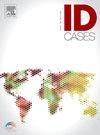A case of W. chitiniclastica bacteremia in a 38-year-old homeless male originating from a maggot-infested amputated foot
IF 1.1
Q4 INFECTIOUS DISEASES
引用次数: 0
Abstract
Wohlfahrtiimonas (W.) chitiniclastica was first isolated from the larval stage of the fly vector Wohlfahrtia magnifica. It is a gram-negative, non-motile, strictly aerobic rod that thrives in temperatures between 28º C and 37º C. Its strong chitinase activity aids in metamorphosis, which suggests a symbiotic relationship with the fly. Although rare, W. chitiniclastica has been implicated in human infections, like bacteremia and osteomyelitis, typically transmitted through fly larvae in skin wounds. Over the past decade, there have been 12 documented human infections, including five confirmed cases of bacteremia. We present a case involving a 38-year-old homeless male with W. chitiniclastica bacteremia secondary to maggot-infested wounds. The patient had a medical history of late latent syphilis and previous frostbite requiring right transmetatarsal amputation and presented with a stump infection on the right foot, featuring maggots. He was afebrile with stable signs and blood cultures revealed W. chitiniclastica. The pathogen was susceptible to various antibiotics, including cefepime, piperacillin/tazobactam, meropenem, trimethoprim-sulfamethoxazole, and levofloxacin. The patient was treated with piperacillin/tazobactam and later transitioned to oral trimethoprim-sulfamethoxazole but left against medical advice. This case underscores the intersection of infectious diseases and social inequalities, highlighting the need for clinicians to consider W. chitiniclastica in patients with poor hygiene, alcoholism, peripheral vascular disease, and open wounds. It also emphasizes the dual role of maggots in wound care, capable of both cleaning necrotic tissue and introducing pathogenic bacteria.
一名38岁无家可归男性几丁质裂殖芽胞杆菌菌血症病例,源自蛆感染的截肢足。
本研究首次从蝇媒大褐飞虫幼虫中分离到几丁虫病单胞菌。它是一种革兰氏阴性、无运动、严格需氧的杆状体,在28ºC至37ºC的温度下生长。它的几丁质酶活性强,有助于变态,这表明它与苍蝇有共生关系。虽然罕见,但几丁质裂体微孢子虫与人类感染有关,如菌血症和骨髓炎,通常通过皮肤伤口的苍蝇幼虫传播。在过去十年中,有12例记录在案的人类感染,包括5例确诊的菌血症病例。我们报告一例涉及一名38岁无家可归的男性与继发于蛆感染伤口的几丁质裂殖芽胞杆菌菌血症。患者有晚期潜伏梅毒病史,既往冻伤需要右经跖骨截肢,右脚残肢感染,以蛆为特征。他不发烧,体征稳定,血液培养显示几丁杆菌。该病原菌对头孢吡肟、哌拉西林/他唑巴坦、美罗培南、甲氧苄啶-磺胺甲恶唑、左氧氟沙星等多种抗生素敏感。患者接受哌拉西林/他唑巴坦治疗,后来转为口服甲氧苄啶-磺胺甲恶唑,但不遵医嘱离开。本病例强调了传染病与社会不平等的交叉关系,强调了临床医生在卫生条件差、酗酒、周围血管疾病和开放性伤口患者中考虑几丁虫病的必要性。它还强调了蛆在伤口护理中的双重作用,既能清洁坏死组织,又能引入致病菌。
本文章由计算机程序翻译,如有差异,请以英文原文为准。
求助全文
约1分钟内获得全文
求助全文

 求助内容:
求助内容: 应助结果提醒方式:
应助结果提醒方式:


